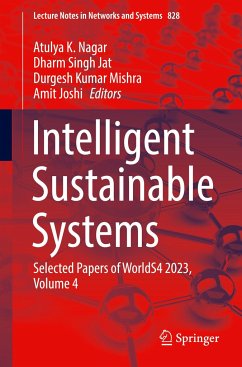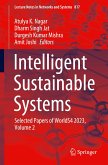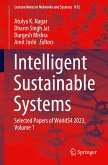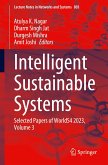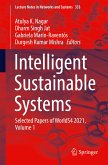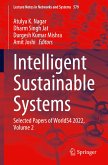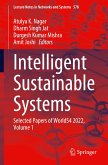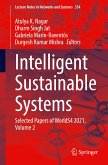Intelligent Sustainable Systems
Selected Papers of WorldS4 2023, Volume 4
Herausgegeben:Nagar, Atulya K.; Jat, Dharm Singh; Mishra, Durgesh Kumar; Joshi, Amit
Intelligent Sustainable Systems
Selected Papers of WorldS4 2023, Volume 4
Herausgegeben:Nagar, Atulya K.; Jat, Dharm Singh; Mishra, Durgesh Kumar; Joshi, Amit
- Broschiertes Buch
- Merkliste
- Auf die Merkliste
- Bewerten Bewerten
- Teilen
- Produkt teilen
- Produkterinnerung
- Produkterinnerung
This book provides insights of World Conference on Smart Trends in Systems, Security and Sustainability (WS4 2023) which is divided into different sections such as Smart IT Infrastructure for Sustainable Society; Smart Management Prospective for Sustainable Society; Smart Secure Systems for Next Generation Technologies; Smart Trends for Computational Graphics and Image Modeling; and Smart Trends for Biomedical and Health Informatics. The proceedings is presented in four volumes. The book is helpful for active researchers and practitioners in the field.
Andere Kunden interessierten sich auch für
![Intelligent Sustainable Systems Intelligent Sustainable Systems]() Intelligent Sustainable Systems150,99 €
Intelligent Sustainable Systems150,99 €![Intelligent Sustainable Systems Intelligent Sustainable Systems]() Intelligent Sustainable Systems153,99 €
Intelligent Sustainable Systems153,99 €![Intelligent Sustainable Systems Intelligent Sustainable Systems]() Intelligent Sustainable Systems171,99 €
Intelligent Sustainable Systems171,99 €![Intelligent Sustainable Systems Intelligent Sustainable Systems]() Intelligent Sustainable Systems112,99 €
Intelligent Sustainable Systems112,99 €![Intelligent Sustainable Systems Intelligent Sustainable Systems]() Intelligent Sustainable Systems223,99 €
Intelligent Sustainable Systems223,99 €![Intelligent Sustainable Systems Intelligent Sustainable Systems]() Intelligent Sustainable Systems223,99 €
Intelligent Sustainable Systems223,99 €![Intelligent Sustainable Systems Intelligent Sustainable Systems]() Intelligent Sustainable Systems164,99 €
Intelligent Sustainable Systems164,99 €-
-
-
This book provides insights of World Conference on Smart Trends in Systems, Security and Sustainability (WS4 2023) which is divided into different sections such as Smart IT Infrastructure for Sustainable Society; Smart Management Prospective for Sustainable Society; Smart Secure Systems for Next Generation Technologies; Smart Trends for Computational Graphics and Image Modeling; and Smart Trends for Biomedical and Health Informatics. The proceedings is presented in four volumes. The book is helpful for active researchers and practitioners in the field.
Produktdetails
- Produktdetails
- Lecture Notes in Networks and Systems 828
- Verlag: Springer / Springer Nature Singapore / Springer, Berlin
- Artikelnr. des Verlages: 978-981-99-8110-6
- 2024
- Seitenzahl: 396
- Erscheinungstermin: 8. März 2024
- Englisch
- Abmessung: 235mm x 155mm x 22mm
- Gewicht: 598g
- ISBN-13: 9789819981106
- ISBN-10: 9819981107
- Artikelnr.: 69110677
- Herstellerkennzeichnung
- Springer-Verlag GmbH
- Tiergartenstr. 17
- 69121 Heidelberg
- ProductSafety@springernature.com
- Lecture Notes in Networks and Systems 828
- Verlag: Springer / Springer Nature Singapore / Springer, Berlin
- Artikelnr. des Verlages: 978-981-99-8110-6
- 2024
- Seitenzahl: 396
- Erscheinungstermin: 8. März 2024
- Englisch
- Abmessung: 235mm x 155mm x 22mm
- Gewicht: 598g
- ISBN-13: 9789819981106
- ISBN-10: 9819981107
- Artikelnr.: 69110677
- Herstellerkennzeichnung
- Springer-Verlag GmbH
- Tiergartenstr. 17
- 69121 Heidelberg
- ProductSafety@springernature.com
Atulya K. Nagar holds a Foundation Chair as Professor of Mathematical Sciences and is Pro-Vice-Chancellor for Research at Liverpool Hope University, UK. He has been the founding Dean of the Faculty of Science and also the founding Head of the School of Mathematics, Computer Science and Engineering, which he established at the university. He is an Internationally Respected Scholar working at the cutting edge of theoretical computer science, applied mathematical analysis, operations research and systems engineering. He received a prestigious Commonwealth Fellowship to pursue his doctorate (D.Phil.) in Applied Nonlinear Mathematics, which he earned from the University of York (UK) in 1996. He holds a B.Sc. (Hons.), an M.Sc. and an M.Phil. (with distinction) in Mathematical Physics from the MDS University of Ajmer, India. His research expertise spans both applied mathematics and computational methods for nonlinear, complex and intractable problems arising in science, engineering and industry. Dharm Singh Jat received his Master of Engineering and Ph.D. in Computer Science and Engineering from prestigious universities in India. He is Professor of Computer Science at Namibia University of Science and Technology (NUST). From 1990 to 2014, he was with the College of Technology and Engineering, Maharana Pratap University of Agricultural and Technology-[MPUAT], Udaipur, India. He has guided about 8 Ph.D. and 24 master's research scholars. He is Author of more than 150 peer-reviewed articles and Author or editor of more than 20 books. His interests span the areas of multimedia communications, wireless technologies, mobile communication systems, edge roof computing and software-defined networks, network security, Internet of Things. He has given several guest lecturer/invited talks at various prestigious conferences. He is Fellow of The Institution of Engineers (I), Fellow of Computer Society of India, Chartered Engineer (I), Senior Member IEEE and Distinguished ACM Speaker. He also developed experiments based on simulation software for network experiments, research and project work for undergraduate and postgraduate students. His research is in developing video communication platforms for solving QoS issues in video communications and also developed a framework for video transmission over wireless networks for undergraduate and postgraduate students. Durgesh Kumar Mishra has received M.Tech. degree in Computer Science from DAVV, Indore, in 1994 and Ph.D. degree in Computer Engineering in 2008. Presently, he has been working as Director and Professor (CSE), Symbiosis University of Applied Sciences, Indore, India. Founder Director, Microsoft Innovation Center (LAB) at SAIT. He is also Visiting Faculty at IIT-Indore, MP, India. He has 24 years of teaching and 10 years of research experience. He completed his Ph.D. under the guidance of Dr. M. Chandwani on Secure Multi-Party Computation for Preserving Privacy. He has published more than 90 papers in refereed international/national journals and conferences including IEEE, ACM conferences. He has organized many such conferences like WOCN, CONSEG and CSIBIG in the capacity of Conference General Chair and Editor of conference proceedings. His publications are listed in DBLP, Citeseer-x, Elsevier and Scopus. He is Senior Member of IEEE and held many positions like Chairman IEEE Computer Society Madhya Pradesh Section (2021-2023). Chairman, IEEE MP-Subsection (2011-2012) and Chairman IEEE Computer Society Bombay Chapter (2009-2010). He was Chairman in CSI Division IV Communication at National Level (2014-2016). He visited and delivered his invited talk in Taiwan, Bangladesh, Singapore, Nepal, USA, UK and France. He has authored a book on "Database Management Systems". He has been a consultant to the sales tax and labor department of the government of Madhya Pradesh, India. He has been awarded with "Paper Presenter award at International Level"by CSI. He visited MIT Boston and presented his presentation on Security and Privacy. He also chaired a panel on "Digital Monozukuri" at "Norbert Winner in the 21st century" at Boston. He became Member of Bureau of Indian Standards (BIS), Government of India, for Information Security domain. Amit Joshi is Entrepreneur and Researcher who has completed his graduation (B.Tech.) in Information Technology and M.Tech. in Computer Science and Engineering and completed his research in the areas of Cloud Computing and Cryptography in Medical imaging with a focus on analysis of the current Government Strategies and World forums needs in di¿erent sectors on security purposes. He has an experience of around 10 years in academic and industry in prestigious organizations. He is Active Member of ACM, IEEE, CSI, AMIE, IACSIT-Singapore, IDES, ACEEE, NPA and many other professional societies. Currently, he is International Chair of InterYIT at International Federation of Information Processing (IFIP, Austria). He has presented and published more than 50 papers in National and International Journals/Conferences of IEEE and ACM. He has also edited more than 20 books which are published by Springer, ACM and other reputed publishers. Apart from this academic involvement, he is also associated with the Business and Industry Community across the globe. He is currently Director of Global Knowledge Research Foundation, and his major work area is focused on building and making e¿ective linkages among bureaucrats, industry associations, academic leaders and regulatory authorities for e¿ective connectivity for taking up common issues related to research in di¿erent sectors. He is Director of Knowledge Chamber of Commerce and Industry. He majorly focuses on Academic Tie-ups for Medical, Engineering and Management sectors, and for the same, he is representing the organization in many delegations to countries including USA, UK, Canada, Israel and visited more than 15 countries. He always looks forward and strive for networking in various sectors with a focus on Education and Industry Sector.
Chapter 1:Knowledge management model focused on organizational sustainable development.- Chapter 2:Control of temperature and relative humidity in greenhouse by humidification system using fuzzy logic in LabVIEW.- Chapter 3:An Intelligent Meter with Smart Home Ability for Intelligent Energy Management.- Chapter 4:Enhancing Workplace Safety through Collaborative Technologies: A Case Study in the Manufacturing Industry.- Chapter 5:Lessons from the Past a Historical Literature Review on Cyber Resilience.- Chapter 6:Strategy to Identify Knowledge Management Solutions for Startup Companies.- Chapter 7:Development of a Smart Pole System Utilizing Arduino Technology and the Internet of Things.- Chapter 8:Preparing Future Leaders: Communication Skills and Leadership Development for E-Government & ICT Reforms.- Chapter 9:Six Sigma DMAIC to Improve the Quality of Food Service: KAU Case Study.- Chapter 10:Effects of Humour in Social Robots onChildren's Learning.- Chapter 11:Digital Twin and Metaverse supporting Smart Cities new perspectives and potentials.- Chapter 12:AgriChain: Blockchain-enabled Food Traceability.- Chapter 13:Aid Nexus : A Blockchain Based Financial Distribution System.- Chapter 14:Artificial intelligence in countering disinformation and enemy propaganda in the context of Russia's armed aggression against Ukraine.- Chapter 15:A Reinforcement Learning Model of a Dynamic Solar Panel System for Maximum Energy Harvesting.- Chapter 16:ERP Integration: Enhancing Collaboration in Virtual and Extended Enterprises.- Chapter 17:Exploring the Factors Influencing a Firm's Intent to Adopt Quantum Computing Resources.- Chapter 18:Analysis of data on the audiovisual narrative of the YouTuber Ariana Bolo Arce during 2021.- Chapter 19:The impact of advertising on video games.- Chapter 20:Internal Communication in the Scopus database: Systematic literature review 2019 - 2023.- Chapter 21:Cost management model in the subway and open pit mines: A systematic review.- Chapter 22:Advergame: A case study on young people in Lima, Peru.- Chapter 23:Literature-based Practices for Designing Female-inclusive Software Engineering and Computer Science Programs.- Chapter 24:External Communication: A Systematic Literature Re-view 2019 - 2023.- Chapter 25: Anomaly Detection Across Multi Scale Temporal Data Streams for Human Behavior Modeling.- Chapter 26:Aggregated Framework for Surveillance camera collaboration.- Chapter 27:A Novel Secure Approach for Enhancing Accuracy of Pest Detection with Private Federated Learning using DPSGD.- Chapter 28:Assessment of Home Specific Network Security Training to Prevent Work From Home Culture.- Chapter 29:Parkezy -A Generic Streamlined Intellectual Parking System using ALPR/RFID.- Chapter 30:Improved Intelligent Malware Detection Model in Cloud Environment.- Chapter 31:SMOTE BASED HEART DISEASE DETECTION UTILIZING AI & ML STACKING CLASSIFIER.- Chapter 32:Multi-class Classification of Lung Cancer Detection Using Deep Learning Model.
Chapter 1:Knowledge management model focused on organizational sustainable development.- Chapter 2:Control of temperature and relative humidity in greenhouse by humidification system using fuzzy logic in LabVIEW.- Chapter 3:An Intelligent Meter with Smart Home Ability for Intelligent Energy Management.- Chapter 4:Enhancing Workplace Safety through Collaborative Technologies: A Case Study in the Manufacturing Industry.- Chapter 5:Lessons from the Past a Historical Literature Review on Cyber Resilience.- Chapter 6:Strategy to Identify Knowledge Management Solutions for Startup Companies.- Chapter 7:Development of a Smart Pole System Utilizing Arduino Technology and the Internet of Things.- Chapter 8:Preparing Future Leaders: Communication Skills and Leadership Development for E-Government & ICT Reforms.- Chapter 9:Six Sigma DMAIC to Improve the Quality of Food Service: KAU Case Study.- Chapter 10:Effects of Humour in Social Robots onChildren's Learning.- Chapter 11:Digital Twin and Metaverse supporting Smart Cities new perspectives and potentials.- Chapter 12:AgriChain: Blockchain-enabled Food Traceability.- Chapter 13:Aid Nexus : A Blockchain Based Financial Distribution System.- Chapter 14:Artificial intelligence in countering disinformation and enemy propaganda in the context of Russia's armed aggression against Ukraine.- Chapter 15:A Reinforcement Learning Model of a Dynamic Solar Panel System for Maximum Energy Harvesting.- Chapter 16:ERP Integration: Enhancing Collaboration in Virtual and Extended Enterprises.- Chapter 17:Exploring the Factors Influencing a Firm's Intent to Adopt Quantum Computing Resources.- Chapter 18:Analysis of data on the audiovisual narrative of the YouTuber Ariana Bolo Arce during 2021.- Chapter 19:The impact of advertising on video games.- Chapter 20:Internal Communication in the Scopus database: Systematic literature review 2019 - 2023.- Chapter 21:Cost management model in the subway and open pit mines: A systematic review.- Chapter 22:Advergame: A case study on young people in Lima, Peru.- Chapter 23:Literature-based Practices for Designing Female-inclusive Software Engineering and Computer Science Programs.- Chapter 24:External Communication: A Systematic Literature Re-view 2019 - 2023.- Chapter 25: Anomaly Detection Across Multi Scale Temporal Data Streams for Human Behavior Modeling.- Chapter 26:Aggregated Framework for Surveillance camera collaboration.- Chapter 27:A Novel Secure Approach for Enhancing Accuracy of Pest Detection with Private Federated Learning using DPSGD.- Chapter 28:Assessment of Home Specific Network Security Training to Prevent Work From Home Culture.- Chapter 29:Parkezy -A Generic Streamlined Intellectual Parking System using ALPR/RFID.- Chapter 30:Improved Intelligent Malware Detection Model in Cloud Environment.- Chapter 31:SMOTE BASED HEART DISEASE DETECTION UTILIZING AI & ML STACKING CLASSIFIER.- Chapter 32:Multi-class Classification of Lung Cancer Detection Using Deep Learning Model.

